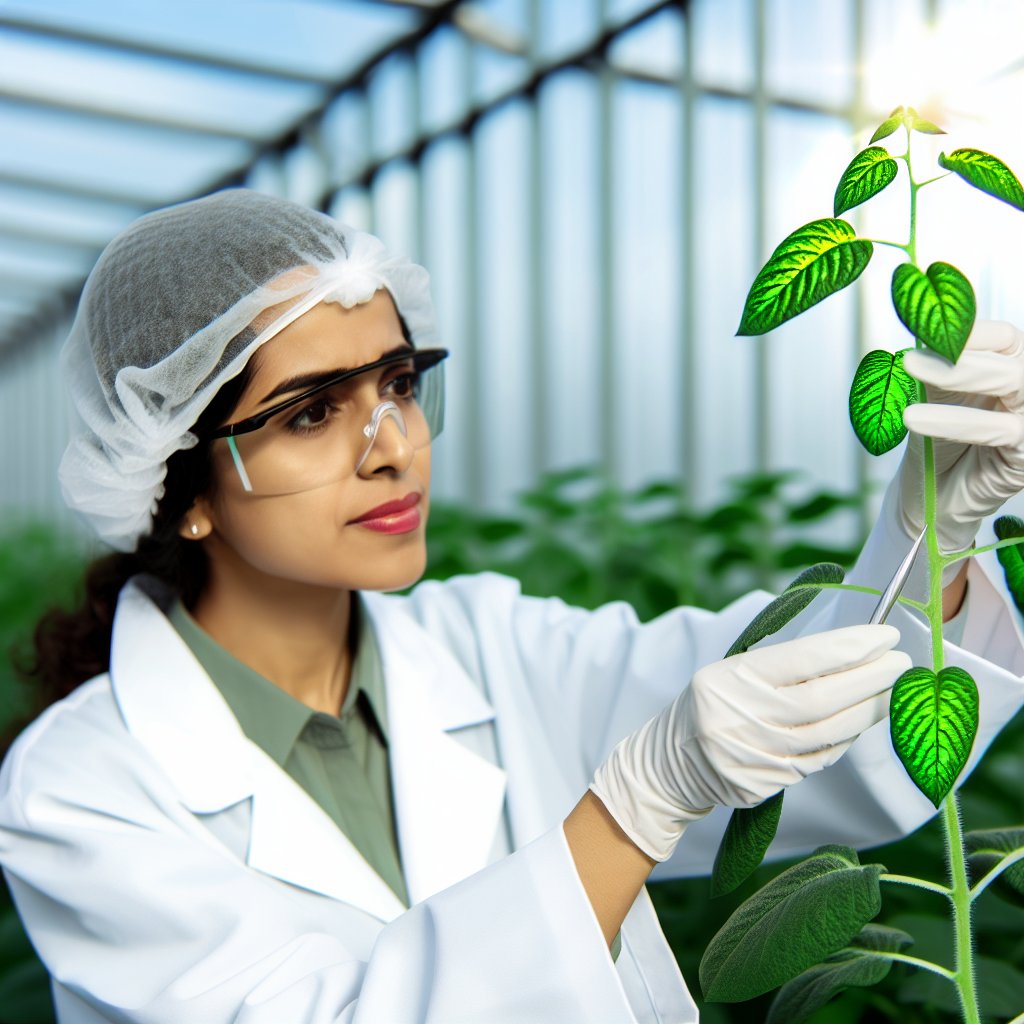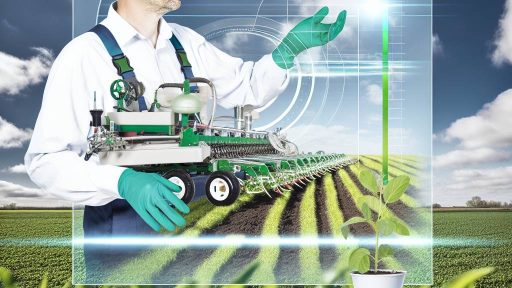Overview of Genetically Modified Crops and Their Importance
Definition and Process
Genetically modified crops are plants whose DNA has been altered through biotechnology.
This modification improves specific traits like resistance to pests and tolerance to herbicides.
Scientists apply techniques such as gene cloning and transformation to create these crops.
Through these processes, they enhance agricultural efficiency and sustainability.
Benefits of Genetically Modified Crops
One significant benefit is increased crop yield.
This boost addresses food security concerns in a growing global population.
Additionally, genetically modified crops require fewer pesticides, thus reducing environmental impact.
Farmers also experience lower production costs in the long run.
Furthermore, some crops are engineered to withstand extreme weather conditions.
This feature is crucial as climate change increasingly affects agriculture.
Challenges and Controversies
Despite their benefits, genetically modified crops face public skepticism.
Concerns about their safety for human consumption and environmental impact persist.
Some critics argue that these crops could lead to biodiversity loss.
Moreover, issues like intellectual property rights also create tension in agricultural communities.
Global Regulations
Several countries have established regulations governing genetically modified crops.
Transform Your Agribusiness
Unlock your farm's potential with expert advice tailored to your needs. Get actionable steps that drive real results.
Get StartedThe United States, Canada, and the European Union each implement distinct policies.
These regulations ensure the safety and efficacy of genetically modified organisms.
They also promote transparency and maintain public trust in agricultural products.
Research and development often occur under strict guidelines to mitigate risks.
International Regulatory Framework for GMOs
Key Organizations Involved
Numerous organizations govern the regulation of genetically modified organisms (GMOs).
These organizations operate at international, regional, and national levels.
The Food and Agriculture Organization (FAO) plays a significant role in this framework.
The World Health Organization (WHO) also contributes to safety assessments.
Additionally, the Organisation for Economic Co-operation and Development (OECD) provides guidelines for genetic research.
Other key entities include the European Food Safety Authority (EFSA) and the U.S. Environmental Protection Agency (EPA).
Important Agreements and Treaties
Various agreements shape international GMO regulations.
The Cartagena Protocol on Biosafety is central to these efforts.
This protocol governs the transboundary movement of GMOs.
The Nagoya-Kuala Lumpur Supplementary Protocol adds further provisions for liability and redress.
Moreover, the Codex Alimentarius provides food safety standards related to GMOs.
Regional Regulatory Approaches
Different regions have unique regulatory frameworks for GMOs.
The European Union implements strict regulations regarding GMO use.
This includes mandatory labeling and risk assessment procedures.
In contrast, the United States follows a more permissive approach.
This framework relies heavily on existing regulations for food and agriculture.
National Regulatory Frameworks
Countries establish their own regulations based on international guidelines.
For instance, Brazil has a comprehensive biosafety law guiding GMO cultivation.
Similarly, Canada utilizes a science-based assessment framework.
China has been updating its regulations to better control GMO research and commercialization.
Showcase Your Farming Business
Publish your professional farming services profile on our blog for a one-time fee of $200 and reach a dedicated audience of farmers and agribusiness owners.
Publish Your ProfileThese national policies vary widely in their strictness and enforcement.
Public Participation and Transparency
Public involvement is essential in GMO regulatory processes.
Governments often seek public comments during the review of GMO proposals.
This transparent approach helps address public concerns.
Moreover, stakeholder engagement fosters trust in regulatory decision-making.
Effective communication of risks and benefits is crucial to this process.
Country-Specific Regulations: A Comparative Analysis
Overview of Global Regulations
Regulations for genetically modified crops vary greatly across countries.
Each nation approaches biotechnology with unique policies and frameworks.
This diversity reflects cultural, environmental, and economic considerations.
For instance, Europe enforces strict rules on GMOs, prioritizing consumer safety.
Conversely, the United States supports biotechnological advancements with fewer restrictions.
Regulations in the United States
The U.S. regulatory framework focuses on the safety of GM crops.
The USDA, FDA, and EPA collaborate to assess and manage risks.
Firstly, the USDA evaluates the environmental impact of GMOs.
Secondly, the FDA ensures that food products derived from GM crops are safe for consumption.
Lastly, the EPA regulates the use of pesticides associated with GM crops.
Regulations in the European Union
The EU adopts a precautionary principle regarding GMOs.
It mandates comprehensive risk assessments before crop approval.
The European Food Safety Authority leads these assessments.
Moreover, any GM product must undergo rigorous labeling requirements.
This approach aims to enhance consumer choice and trust.
Comparative Analysis of Other Regions
In Canada, regulations resemble those in the U.S., focusing on science-based assessments.
However, public sentiment towards GMOs influences policy decisions significantly.
In contrast, countries like India impose strict regulations on GM crops.
These regulations address environmental concerns and food security issues.
Brazil adopts a mixed approach, balancing innovation with public acceptance.
Trends and Future Directions
Global trends indicate a shift towards more collaborative regulatory frameworks.
Countries are increasingly sharing data and aligning policies.
This cooperation can lead to consistent safety standards across borders.
Furthermore, new technologies will likely reshape regulatory practices.
Consequently, an adaptive regulatory framework will become essential.
Find Out More: Enhancing Crop Production Efficiency with Controlled Environment Agriculture
Environmental Safety Assessments for GM Crops
Purpose of Environmental Safety Assessments
Environmental safety assessments aim to identify potential risks associated with GM crops.
These assessments evaluate possible environmental impacts before commercialization.
They ensure that genetically modified crops do not harm ecosystems or biodiversity.
Risk Identification Process
The risk identification process involves several critical steps.
First, researchers conduct thorough literature reviews and field studies.
Next, they collect extensive data on the GM crop’s characteristics and behavior.
Additionally, scientists assess the interactions between GM crops and other organisms.
Evaluation of Ecological Impacts
Evaluating ecological impacts is essential for understanding long-term effects.
Showcase Your Farming Business
Publish your professional farming services profile on our blog for a one-time fee of $200 and reach a dedicated audience of farmers and agribusiness owners.
Publish Your ProfileThis evaluation looks at how GM crops influence soil, water, and air quality.
It also examines the potential effects on non-target organisms.
To inform this process, scientists often conduct ecological modeling studies.
Data Collection Methods
Data collection methods must be comprehensive and systematic.
Researchers often utilize field trials to gather empirical evidence.
They may also use observational studies to analyze environmental interactions.
Remote sensing technology can aid in monitoring changes over time.
Regulatory Framework
A robust regulatory framework guides environmental safety assessments.
Governments and international bodies develop specific guidelines and protocols.
Organizations like the Environmental Protection Agency ensure compliance.
These regulations help balance agricultural innovation with environmental protection.
Stakeholder Involvement
Involving stakeholders is vital for the success of safety assessments.
This includes farmers, environmental groups, scientists, and policymakers.
Stakeholder engagement fosters transparency and public trust in GM crops.
Moreover, it allows for diverse perspectives to shape assessment processes.
Ongoing Monitoring and Evaluation
Ongoing monitoring of GM crops is crucial post-commercialization.
This monitoring helps track long-term environmental impacts.
Researchers must adapt assessment methodologies as new technologies emerge.
Continuous evaluation ensures that safety standards remain relevant and effective.
Uncover the Details: Organic Pest Control Innovations Promoting Eco-Friendly Farming
Labeling Requirements for Genetically Modified Products
Overview of Labeling Guidelines
Labeling of genetically modified (GM) crops is crucial for consumer transparency.
These labels provide essential information about the product’s origin.
Specifically, they help consumers make informed choices regarding their food.
Legal Framework for Labeling
The legal requirements vary by country and region.
For instance, the United States has guidelines from the USDA.
In contrast, the European Union has stricter regulations regarding GMOs.
Compliance with these laws is essential for market access.
Content of Labels
Labels must clearly indicate the presence of genetically modified ingredients.
Furthermore, they should contain relevant nutritional information.
Other required details may include allergen information and sourcing origins.
Consumer Awareness and Education
Consumer awareness of GM labeling impacts purchasing decisions.
Educational initiatives can help inform the public about GM technologies.
Understanding the benefits and risks will enhance consumer trust.
Enforcement of Labeling Regulations
Government entities are responsible for enforcing labeling regulations.
They conduct inspections and impose penalties for non-compliance.
Companies must ensure their labels meet all regulatory requirements.
Future Trends in Labeling
The evolution of labeling guidelines is ongoing due to consumer demand.
Innovations in technology may lead to more informative labels.
As a result, transparency will continue to improve in the food supply chain.
Discover More: Understanding Modern Crop Disease Detection Technologies For Sustainable Farming
Showcase Your Farming Business
Publish your professional farming services profile on our blog for a one-time fee of $200 and reach a dedicated audience of farmers and agribusiness owners.
Publish Your Profile
Ethical Considerations in the Regulation of GM Crops
The Importance of Ethics in Biotechnology
Ethics play a crucial role in regulating genetically modified crops.
Strong ethical guidelines help ensure responsible development and use.
They foster public trust and confidence in biotechnology innovations.
Moreover, ethics can guide decision-making processes involved in genetic engineering.
Public Perception and Acceptance
The public’s perception of GM crops greatly influences regulatory policies.
Many consumers express concerns regarding safety and environmental impacts.
Therefore, regulators must consider public opinion in their guidelines.
Transparency in research and development builds trust among stakeholders.
Engaging in open discussions can alleviate misconceptions about GM technology.
Environmental and Ecological Considerations
Ethical regulation must account for environmental sustainability.
Potential risks to biodiversity should be thoroughly assessed.
This includes impacts on non-target species and ecosystem functions.
Furthermore, ethical frameworks should promote practices that protect natural habitats.
Regulatory guidelines must encourage responsible crop management practices.
Social Justice and Equity
GM crop regulation must prioritize social justice and equitable access.
Benefits of biotechnology should be accessible to all farmers, regardless of size.
Smallholder farmers often face barriers to adopting new technologies.
Thus, regulators must ensure fair distribution of resources and support.
Promoting equity can enhance the overall benefits of agricultural advancements.
Future Considerations and Emerging Technologies
As technologies evolve, ethical guidelines must adapt accordingly.
Regulators need to keep pace with innovations in genetic research.
Continuous ethical assessments can help identify potential risks and benefits.
Stakeholders should collaborate to create responsive regulatory frameworks.
Ultimately, adapting to new challenges is key to sustainable agricultural practices.
Discover More: Overcoming Challenges With Genetically Modified Crop Adoption
The Role of Public Engagement and Transparency in GMO Regulation
Importance of Public Engagement
Public engagement plays a crucial role in GMO regulation.
It fosters trust between stakeholders and regulatory bodies.
Moreover, it empowers consumers to make informed choices.
On top of that, active participation can guide policy-making.
Methods of Public Engagement
Various methods enhance public engagement in GMO discussions.
Workshops and community forums facilitate open dialogue.
Online platforms provide accessible information and feedback channels.
Surveys can gauge public opinion on GMO practices and regulations.
Transparency in Regulation
Transparency is vital in the regulation of genetically modified crops.
Clear communication of research findings fosters public trust.
Regulatory agencies must disclose safety assessments transparently.
This openness encourages stakeholder participation in the regulation process.
Building Stakeholder Trust
A transparent approach helps build trust among stakeholders.
Trust strengthens the relationship between regulators and the public.
Additionally, it can lead to better acceptance of GMO technology.
Showcase Your Farming Business
Publish your professional farming services profile on our blog for a one-time fee of $200 and reach a dedicated audience of farmers and agribusiness owners.
Publish Your ProfileFarmer and consumer confidence increases with transparent practices.
Future Directions
Looking ahead, enhancing engagement strategies remains essential.
Regulatory bodies should continuously seek public input.
Increased collaboration between scientists and communities is key.
Innovative communication methods can make information more relatable.
Future Trends in Regulatory Guidelines for GM Crop Development
Increased Emphasis on Environmental Impact
Regulatory bodies will focus more on environmental assessments for GM crops.
This change comes as society grows increasingly concerned about biodiversity.
Moreover, sustainability will drive policy decisions moving forward.
Government agencies may implement stricter guidelines on ecosystem effects.
Consequently, developers will need to prioritize eco-friendly practices.
Advancements in Biotechnology Innovation
Innovations in biotechnology will influence regulatory frameworks significantly.
New gene editing technologies, like CRISPR, will challenge existing regulations.
Policymakers will need to adapt to the fast pace of scientific development.
Flexibility in guidelines will be essential to accommodate emerging technologies.
This will result in more dynamic regulatory environments worldwide.
Public Engagement and Transparency Initiatives
Future regulations will likely include enhanced public engagement efforts.
Transparent communication will be critical to address public concerns.
Building trust with consumers will help mitigate skepticism about GM crops.
Regulators may develop educational campaigns to clarify the benefits of GM technologies.
Additionally, stakeholder input will shape the development of new regulations.
Global Harmonization of Regulatory Standards
Efforts to harmonize global regulatory standards will gain traction.
Countries will recognize the need for cohesive guidelines in GM crop development.
This initiative will facilitate international trade and collaboration.
As a result, multinational companies will benefit from clearer regulations.
Moreover, harmonization will help address safety and environmental concerns globally.
Increased Focus on Human Health and Safety
Regulatory agencies will place greater emphasis on health and safety assessments.
Long-term studies regarding GM crop consumption will become more prevalent.
Regulations will likely include routine monitoring for adverse health effects.
This focus will help reassure consumers about the safety of GM products.
To this end, policymakers may require comprehensive risk assessments before approval.




